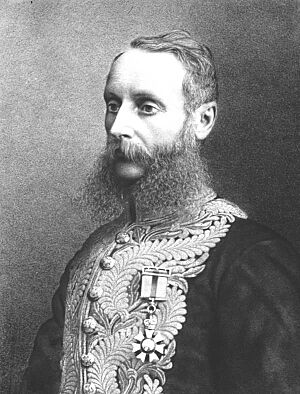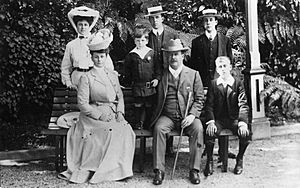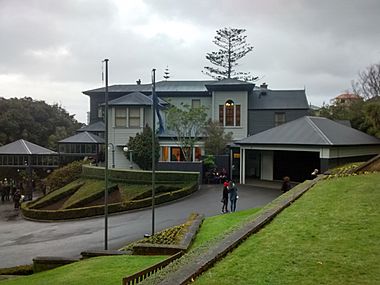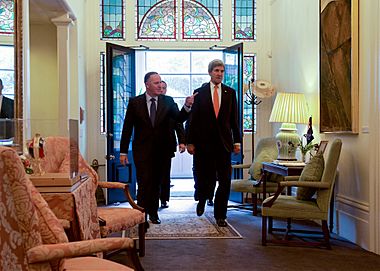Premier House facts for kids
Quick facts for kids Premier House |
|
|---|---|
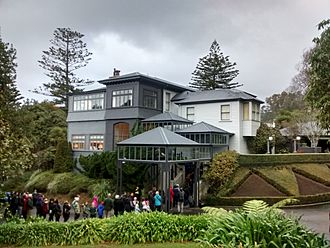
Premier House during an open day in 2015
|
|
| General information | |
| Location | 41°16′36.4″S 174°46′14.8″E / 41.276778°S 174.770778°E |
| Address | 260 Tinakori Road, Thorndon |
| Town or city | Wellington |
| Country | New Zealand |
| Current tenants | Jacinda Ardern, Prime Minister of New Zealand, and Clarke Gayford |
| Owner | Her Majesty's New Zealand Government |
| Designated: | 24 March 1988 |
| Reference #: | 1371 |
Premier House (Māori: Te Whare Pirimia) is the official home of the Prime Minister of New Zealand. It is located at 260 Tinakori Road in Thorndon, Wellington, New Zealand.
This house was bought to be the Prime Minister's official residence when the government moved to Wellington in 1865. It was first made much bigger. Later, as the wooden building got old, some leaders avoided it because repairs were too costly.
It was rented out to private people for six years in the late 1890s. Then it became the Prime Minister's home again until 1935. A new government wanted to avoid "showing off" during the Great Depression. For over 50 years, many children knew the building as their dental clinic. It was fixed up and reopened as Premier House in 1990.
Contents
The House's Early Days
How Premier House Was Built
The first part of the house was built in 1843. It was for George Hunter, who was Wellington's first Mayor. This original part is still at the southern end of the building today. Over the years, the house has been made much larger.
Later, the house belonged to Nathaniel Levin. The government bought it from Richard Collins in March 1865. It cost £2900 to become the official home for the nation's Premier. Wellington's The Evening Post newspaper thought the price was "cheap." Auckland's Daily Southern Cross called it "one of the handsomest villas in the country." However, The New Zealand Herald in Auckland called the purchase "a piece of illegal extravagance."
Making the House Bigger
The house stayed mostly the same until Julius Vogel and his wife, Mary, arrived in 1873. Within a year, they had turned it into a huge home with eight bedrooms. It also had a special room for plants (a conservatory) and a ballroom for dancing. The outdoor area even had what is believed to be New Zealand's first tennis court. The Vogels were known for hosting many fancy parties. Because of this, the house earned the nickname "The Casino."
Who Lived in Premier House?
Many important leaders have lived in Premier House. Here are some of them:
- 1864–1865: Hon Sir Frederick Weld, 6th Premier. His government finished buying the house.
- 1865–1869: Hon Sir Edward Stafford, 3rd Premier.
- 1869–1873: Hon Sir William Fox, 2nd Premier.
- 1873–1875: Hon Sir Julius Vogel, 8th Premier. He made the house much bigger during his time.
- 1876–1876: Hon Sir Julius Vogel, 8th Premier.
- 1879–1882: Hon Sir John Hall, 12th Premier.
- 1882–1883: Hon Sir Frederick Whitaker, 5th Premier.
- 1883–1884: Hon Sir Harry Atkinson, 10th Premier.
- 1884–1887: Hon Sir Julius Vogel as a cabinet minister. More parts were added to the house because Vogel was often sick. He had a condition called gout, so an extra office was built for meetings. In 1886, New Zealand's first lift was installed.
New Zealand faced tough economic times in the late 1880s. After the Vogels moved out, the government tried to sell the property. But people in Wellington liked its large grounds as a public space. So, only the furniture was sold. The house stayed empty for a while.
- 1887–1891: Hon Sir Harry Atkinson, 10th Premier.
- 1891–1893: Rt Hon John Ballance, 14th Premier.
- 1893–1906: Rt Hon Richard John Seddon, 15th Premier. After Ballance died, Seddon stayed in his smaller home. The Tinakori Street house was rented out from 1895 to 1900.
Who Rented the House?
- 1895–1899: Sir Walter Buller, a lawyer and expert on birds.
- 1899–1899: Percy Smith, a surveyor and expert on human cultures.
Official Residents Again
- 1900–1912: Rt Hon Sir Joseph Ward Bt. He was a cabinet minister and then Prime Minister from 1906. The house was renamed Awarua, after Ward's home area. It became a popular place for parties and gatherings, especially after Ward became Prime Minister.
- 1912–1925: Rt Hon William F Massey, Prime Minister. He renamed it Ariki Toa, which means ‘home of the chief’. During the First World War, the Masseys used the house for activities to support the country.
- 1925–1928: Rt Hon J Gordon Coates, Prime Minister. He was the last Prime Minister to live there for a while. More parts were added to the building in 1926 when Gordon Coates lived there. This included rebuilding the conservatory.
- 1928–1935: Rt Hon George Forbes, Prime Minister. He lived in a flat at Parliament House instead. Parts of Premier House's floor had sunk by a lot. The ground floor was used by government departments. The upper floor was used by families of other ministers. People wanted the house to stay as it was, not be divided up. The garden continued to host parties to raise money for charities like the YWCA and Girl Guides.
The Dental Clinic Years
In 1935, Prime Minister Michael Joseph Savage faced the challenge of rebuilding the country's economy during the Great Depression. He chose to live in a different house. Premier House was then turned into a school for dental nurses and a dental clinic for children. Many children in New Zealand knew it as the place where they went to get their teeth checked. During World War II, the garden was used to grow vegetables for the local Armed Forces Service Clubs.
Bringing Premier House Back to Life
After many years of being used as a clinic, the building was in bad shape by the 1980s. Michael Bassett, the Minister of Internal Affairs, helped save it. He started plans to bring the building back to its grand old style.
The restoration work was done by Grant Group Architects and L.T. McGuinness Construction. It took place between December 1989 and 1991. The inside walls were kept, and most rooms stayed in their original places. New systems like fire sprinklers, central heating, and air conditioning were put in. A new hydraulic lift was also added. The inside of the house now looks like it did in the 1800s, but with modern touches. It also has a large collection of New Zealand art.
The fixing up of Premier House was a special project for New Zealand's 150th anniversary in 1990. That year, Geoffrey Palmer and his wife, Margaret, became the first official residents after the restoration. In 2018, the house was updated again with repairs and maintenance costing about NZ$3 million.
Recent Prime Ministers at Premier House
- 1989–1990: Geoffrey Palmer
- 1990–1990: Mike Moore
- 1990–1997: Jim Bolger
- 1997–1999: Jenny Shipley
- 1999–2008: Helen Clark
- 2008–2016: John Key
- 2017–present: Jacinda Ardern
Why Some Prime Ministers Didn't Live There
Prime Minister Bill English (2016–2017) did not live at Premier House. This was because New Zealand law says that Members of Parliament who live in Wellington cannot claim money from taxpayers for housing in the capital. His successor, Jacinda Ardern, who lives in Auckland, moved into the official residence.
How Much is Premier House Worth?
The property covers a large area of 1.5 hectares (about 14,569 square metres). In 2020, its estimated value was NZ$23,300,000.
Other Official Homes for Prime Ministers
64-66 Harbour View Road
From 1939, Michael Joseph Savage lived in a house called “Hill Haven” at 64-66 Harbour View Road in Northland, Wellington. Before that, he lived at 47 Molesworth Street. His successor, Peter Fraser, also used this house until 1949. It was bought for Michael Joseph Savage because it was no longer necessary for the Prime Minister to live very close to Parliament.
41 Pipitea Street
From 1950, Sidney Holland lived at 41 Pipitea Street in Thorndon. This house was later used by Walter Nash, Keith Holyoake, and Geoffrey Palmer. It was also used as a home for other ministers and for the Pacific Island Affairs Ministry.
Vogel House
From 1976 to 1990, Vogel House in Lower Hutt was the official home for the Prime Minister. Robert Muldoon and other leaders used it during this time.


